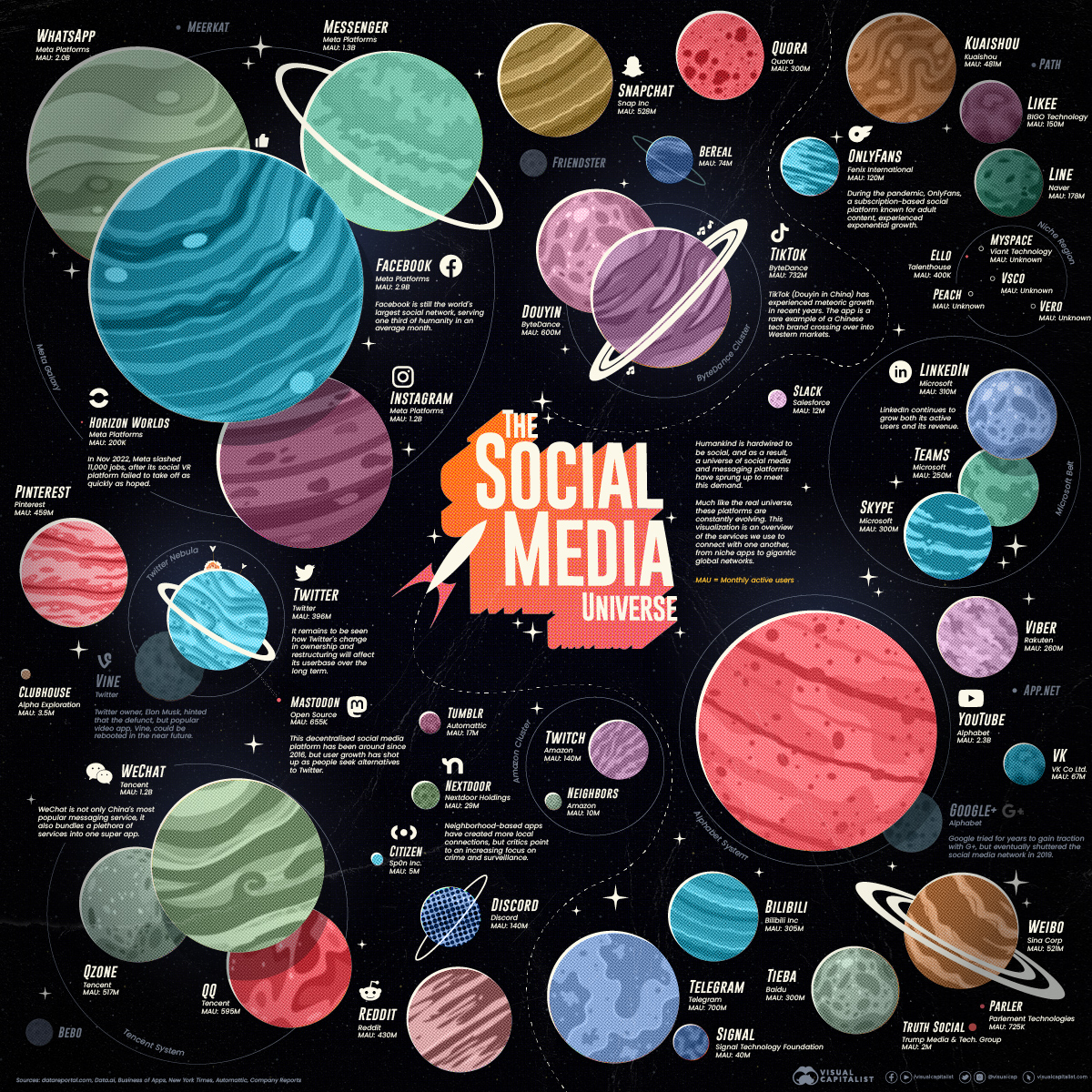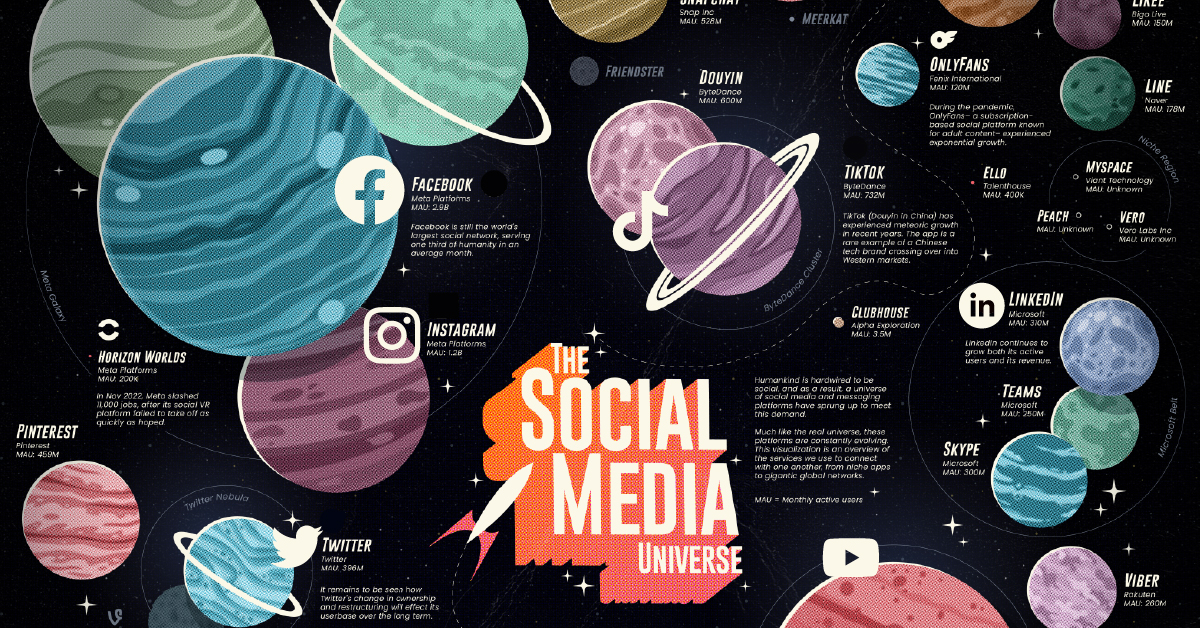Technology
Visualizing the World’s Top Social Media and Messaging Apps
View the high-resolution version of this infographic.
The Social Media Universe in 2022
For a time, life in the social media universe was mostly uneventful. Consider these spicy (at the time) headlines:
- Even President Obama Thinks That Facebook Isn’t Cool Anymore (Techcrunch, 2014)
- Jack Dorsey Returns to Twitter as Chief, to Shrugs and Quips (New York Times, 2015)
- Instagram’s new stories are a near-perfect copy of Snapchat (Mashable, 2016)
In hindsight, the years leading up to 2016 were downright sleepy in comparison with what would follow. Donald Trump’s meteoric, tweet-powered rise to the presidency. The Cambridge Analytica scandal. Congressional hearings on privacy and bias. TikTok at the center of souring U.S.–China relations. Each new day brought a fresh wave of controversy the shores of once infallible social media platforms.
Today, the honeymoon phase is long over and the messiness of running a global social platform is now on full display. Nowhere is this more evident than Twitter during the current Elon Musk transitional period—but more details on that later.
For now, let’s explore the social media universe in 2022.
Mapping the Social Media and Messaging Universe
In 2022, the social universe is looking more crowded than in previous years.
The scale of Meta’s platforms still dominate thanks to their global reach, but there are a number of smaller networks fighting for market share. Here’s a look at popular platforms, organized from largest to smallest active userbase:
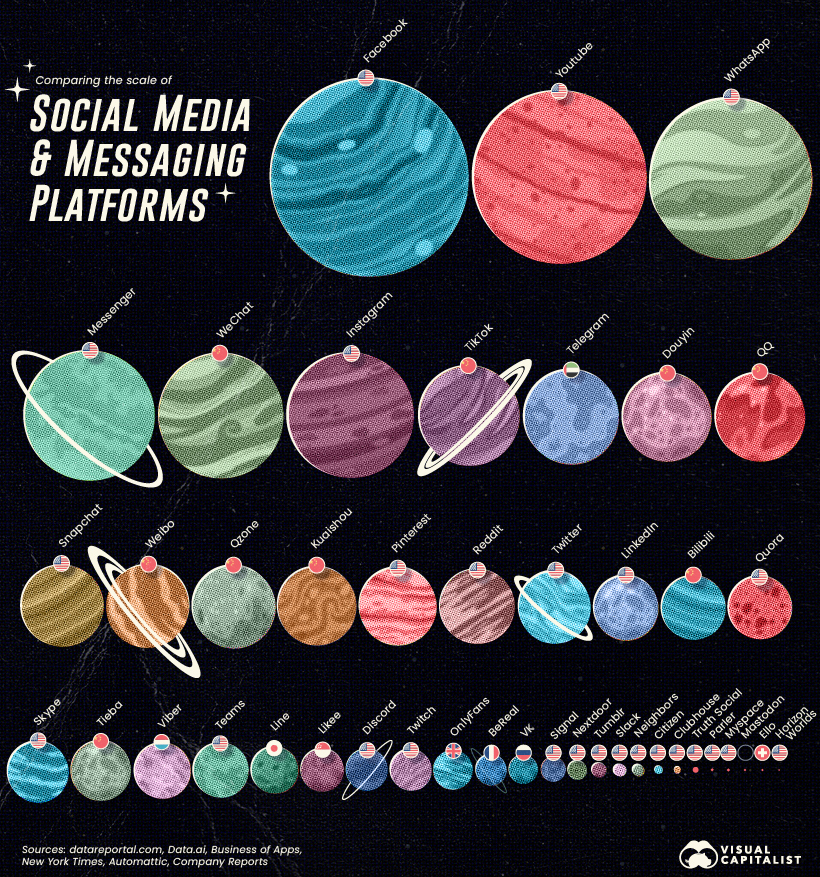
Meanwhile, here are the top 10 social media and messaging platforms by publicly-available monthly active users:
| Rank | Platform Name | Parent Company | Primary Function | Monthly Active Users |
|---|---|---|---|---|
| #1 | Meta Platforms | Social network | 2.9 billion | |
| #2 | YouTube | Alphabet | Video content | 2.3 billion |
| #3 | Meta Platforms | Messaging | 2.0 billion | |
| #4 | Messenger | Meta Platforms | Messaging | 1.3 billion |
| #5 | Meta Platforms | Video content | 1.2 billion | |
| #6 | Tencent | Messaging | 1.2 billion | |
| #7 | TikTok | ByteDance | Video content | 732 million |
| #8 | Telegram | n/a | Messaging | 700 million |
| #9 | Douyin | ByteDance | Video content | 600 million |
| #10 | Tencent | Messaging | 595 million |
YouTube is the only true competition for Meta’s scale and reach. Alphabet’s video content hub with social features boasts more than two billion monthly active users. YouTube’s embrace of the creator economy is nudging the platform further into pure social media territory with the introduction of “handles”.
As seen in the visualization above, China has its own ecosystem of large social and messaging platforms—the largest of these being WeChat.
The only platform in the top 20 that is not based in either the U.S. or China is the privacy-focused messaging app, Telegram. The Dubai-based company has a unique backstory. It was created after the founders of Russian social network VK left the country after resisting government pressure to release data on the social network’s users in Ukraine.
Today, there are also a number of smaller, special interest platforms. OnlyFans, for example, is focused on adult content creators. Parler and Truth Social appeal to users who want fewer constraints on the content they post and consume. BeReal aims to create more authentic moments by prompting users to post a photo at a random time each day.
Below, we dig into a few of these platforms into more depth.

Big Trouble in Little Metaverse
Having a figurehead CEO is a double-edged sword. When things are going well, the market rallies around the successful leader. Case in point, Mark Zuckerberg was named Time’s Person of the Year in 2010. Even as recently as 2016, Glassdoor named the Facebook founder the “most admired tech CEO”.
On the flip side, when the tide turns, it turns fast. After a series of controversies, Zuckerberg took a multi-billion-dollar gamble by renaming his entire company Meta and pivoting its focus to the burgeoning idea of a metaverse. Meta’s New Horizons platform is rumored to have plateaued at about 200,000 active users, which is underwhelming for a company that still reaches a sizable slice of humanity with its other services.
Part of Meta’s near-term success hinges on VR headsets being a hot gift this holiday season. Meta’s cheapest headset is $400, which could be a tough sell in today’s economic environment.
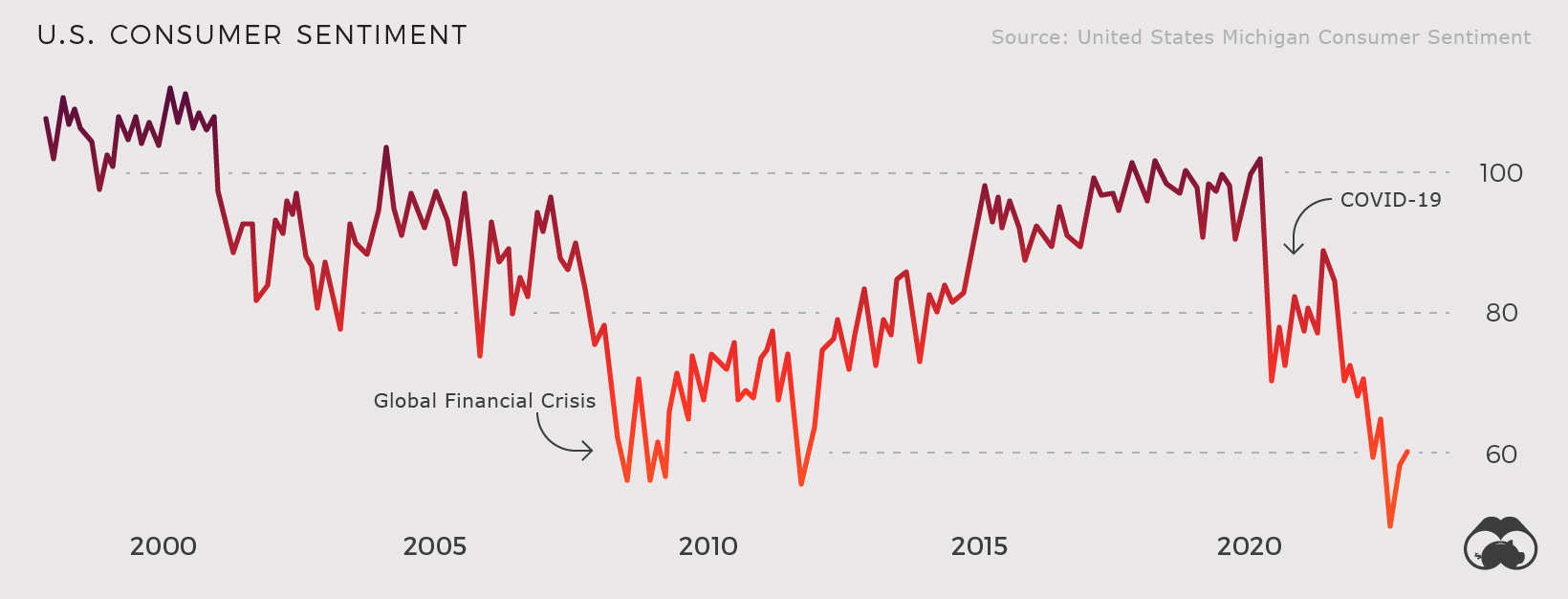
Of course, it’s too early to know whether Zuckerberg’s gamble will pay off. As always, all is forgiven once a business unit takes off and becomes profitable.

Microblogging with Macro Expectations
Twitter has a complicated history.
The company was launched in the shadow of Facebook’s massive growth, and was saddled with expectations that were tough to meet. Although Twitter has an engaged and influential audience, it hasn’t managed to monetize them at the level of Meta’s platforms (for better or worse). The introduction of Twitter Blue in 2021 did not resonate with users at the scale the company hoped, and “fleets” were essentially written off as a failed experiment.
In addition, Twitter is a magnet for criticism and debate around free speech, in part because of its central place in political discourse.
These issues are directly related to the company’s recent sale to Elon Musk. At the time of this article, Twitter finds itself in the midst of a painful, and very public, internal restructuring.
If reports of an exodus of talent and advertising dollars are to be believed, then the future of one of world’s most influential social media platforms could be at risk.

TikTok
Social media has always been dominated by Facebook and its related apps. When a new challenger came along, Facebook either acquired it (Instagram, WhatsApp), or “acquired” their features (Snapchat). TikTok is the first challenger to keep its momentum and growth, even as Instagram rolled out very similar features.
TikTok is also a rare case of a Chinese tech product crossing over into Western markets. The ascendancy of TikTok was not without controversy though. Suspicion over Chinese access to user data continues to be an issue both in the U.S., and in other large markets around the world. TikTok has been banned in India since 2020.
Despite these headwinds, TikTok remains wildly popular. The short-form video platform was the number one downloaded app on the planet, and it remains a favorite of the all-important Gen Z demographic.
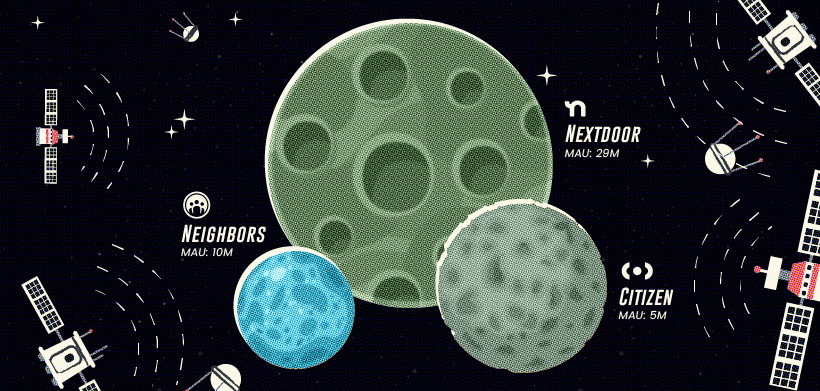
We Shall Surveil
In recent years, neighborhood-based social networks have sprung up and gained traction. NextDoor used physical letters sent to adjacent addresses to supercharge its growth, while Neighbors piggybacked off the popularity of Ring’s doorbell cameras. Although members post about more benign topics such as lost cats and where to find a good plumber, crime is an increasingly common theme as well.
Apps like Neighbors and Citizen have a more overt focus on crime and safety. While the growth of these apps reflects an obvious interest preventing crime, critics point out that the ubiquity of personal surveillance equipment and forums built purely around public safety promote a culture of suspicion in communities.
This type of social network is still quite new, so it remains to be seen if they remain niche communities, or grow into something bigger.
Chaos and Opportunity
It was Sun Tzu who famously said, “In the midst of chaos, there is also opportunity”.
This is the risk and opportunity in the social media universe today. With their massive networks and high switching costs (e.g. personalization, library of existing posts), the largest platforms have created moats that make life hard for upstart brands looking to replace established platforms. On the other hand, controversy on platforms like Twitter and Facebook may cause some users to consider new options.
The multi-billion-dollar question—is dissatisfaction with major platforms temporary, or will emerging networks like Mastodon or BeReal hit critical mass and become new staples for people connecting online. Time will tell.
Technology
Visualizing AI Patents by Country
See which countries have been granted the most AI patents each year, from 2012 to 2022.

Visualizing AI Patents by Country
This was originally posted on our Voronoi app. Download the app for free on iOS or Android and discover incredible data-driven charts from a variety of trusted sources.
This infographic shows the number of AI-related patents granted each year from 2010 to 2022 (latest data available). These figures come from the Center for Security and Emerging Technology (CSET), accessed via Stanford University’s 2024 AI Index Report.
From this data, we can see that China first overtook the U.S. in 2013. Since then, the country has seen enormous growth in the number of AI patents granted each year.
| Year | China | EU and UK | U.S. | RoW | Global Total |
|---|---|---|---|---|---|
| 2010 | 307 | 137 | 984 | 571 | 1,999 |
| 2011 | 516 | 129 | 980 | 581 | 2,206 |
| 2012 | 926 | 112 | 950 | 660 | 2,648 |
| 2013 | 1,035 | 91 | 970 | 627 | 2,723 |
| 2014 | 1,278 | 97 | 1,078 | 667 | 3,120 |
| 2015 | 1,721 | 110 | 1,135 | 539 | 3,505 |
| 2016 | 1,621 | 128 | 1,298 | 714 | 3,761 |
| 2017 | 2,428 | 144 | 1,489 | 1,075 | 5,136 |
| 2018 | 4,741 | 155 | 1,674 | 1,574 | 8,144 |
| 2019 | 9,530 | 322 | 3,211 | 2,720 | 15,783 |
| 2020 | 13,071 | 406 | 5,441 | 4,455 | 23,373 |
| 2021 | 21,907 | 623 | 8,219 | 7,519 | 38,268 |
| 2022 | 35,315 | 1,173 | 12,077 | 13,699 | 62,264 |
In 2022, China was granted more patents than every other country combined.
While this suggests that the country is very active in researching the field of artificial intelligence, it doesn’t necessarily mean that China is the farthest in terms of capability.
Key Facts About AI Patents
According to CSET, AI patents relate to mathematical relationships and algorithms, which are considered abstract ideas under patent law. They can also have different meaning, depending on where they are filed.
In the U.S., AI patenting is concentrated amongst large companies including IBM, Microsoft, and Google. On the other hand, AI patenting in China is more distributed across government organizations, universities, and tech firms (e.g. Tencent).
In terms of focus area, China’s patents are typically related to computer vision, a field of AI that enables computers and systems to interpret visual data and inputs. Meanwhile America’s efforts are more evenly distributed across research fields.
Learn More About AI From Visual Capitalist
If you want to see more data visualizations on artificial intelligence, check out this graphic that shows which job departments will be impacted by AI the most.
-

 Markets1 week ago
Markets1 week agoU.S. Debt Interest Payments Reach $1 Trillion
-

 Markets2 weeks ago
Markets2 weeks agoRanked: The Most Valuable Housing Markets in America
-

 Money2 weeks ago
Money2 weeks agoWhich States Have the Highest Minimum Wage in America?
-

 AI2 weeks ago
AI2 weeks agoRanked: Semiconductor Companies by Industry Revenue Share
-

 Markets2 weeks ago
Markets2 weeks agoRanked: The World’s Top Flight Routes, by Revenue
-

 Countries2 weeks ago
Countries2 weeks agoPopulation Projections: The World’s 6 Largest Countries in 2075
-

 Markets2 weeks ago
Markets2 weeks agoThe Top 10 States by Real GDP Growth in 2023
-

 Money2 weeks ago
Money2 weeks agoThe Smallest Gender Wage Gaps in OECD Countries

